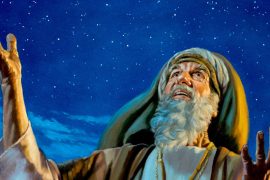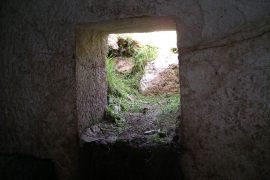Parallels Between A New Dead Sea Scroll Fragment (4Q521)
and the Early New Testament Gospel Tradition
One of the more intriguing of the Dead Sea Scrolls released in the 1990s, after being held by the DSS committee for decades, is a fragment that most now title “Messianic Apocalypse” (4Q521). This text contains three rather striking features that are of particular significance for comparing the apocalyptic beliefs and expectations of the Qumran community with the emerging early Christian movement. First, the text speaks of a single Messiah figure who will rule heaven and earth. Second, it mentions in the clearest language the expectation of the resurrection of the dead during the time of this Messiah. And third, and perhaps most important for students of the New Testament, it contains an exact verbal parallel with the Gospels of Matthew and Luke for identifying of the signs of the Messiah.

First, a translation of the fragment itself:
[the hea]vens and the earth will listen to His Messiah, and none therein will stray from the commandments of the holy ones.
Seekers of the Lord, strengthen yourselves in His service!
All you hopeful in (your) heart, will you not find the Lord in this?
For the Lord will consider the pious (hasidim) and call the righteous by name.
Over the poor His spirit will hover and will renew the faithful with His power.
And He will glorify the pious on the throne of the eternal Kingdom.
He who liberates the captives, restores sight to the blind, straightens the b[ent]
And f[or] ever I will cleav[ve to the h]opeful and in His mercy . . .
And the fr[uit . . .] will not be delayed for anyone.
And the Lord will accomplish glorious things which have never been as [He . . .]
For He will heal the wounded, and revive the dead and bring good news to the poor
. . .He will lead the uprooted and knowledge . . . and smoke (?)
(Michael O. Wise, translation)
The early Christians obviously focused on a single Messiah or Christ, a descendent of king David, whom they identified as Jesus of Nazareth (Mark 8:27-30; Acts 2:36). They clearly saw him as God’s cosmic agent, who would return in power and glory to rule heaven and earth (Mark 14:61-62; 13:26-27). They expected that the entire cosmos would come under subjection to him (Phil 2:9-10; 1 Cor 15:24-28)). They remembered him as one who had power over the demonic spirits, over disease and death, and even over the forces of nature. This exalted view of Jesus is well summed up in the Markan version of the disciples’ exclamation when he calms a storm on the Sea of Galilee: “Who then is this, that even the wind and the sea obey him?” (Mark 4:35-41).
But like those at Qumran, they associated other special figures and groups with the age of the Messiah. John the Baptist was of the Aaronic priesthood and was revered as a returned “Elijah,” a sure sign that the End was near (Mark 9:9-13; Malachi 4:5 [Hebrew 3:23]). The Twelve apostles were expected to sit on thrones over the regathered twelve tribes of Israel in the coming Messianic rule (Matthew 19:28). The followers of Jesus, referred to as the “elect” or “saints,” were expecting to rule over the Gentile nations and even judge angels (1 Corinthians 6:1-4). In line 11 we have a clear reference to the resurrection of the dead. Why is this so significant? Much ink has been spilled over the past few decades discussing whether or not the people who composed the Scrolls believed in the distinctively Jewish doctrine of the resurrection of the dead. We know that various Jewish groups during the Second Temple period disputed over this doctrine of the afterlife. The first references to the idea of the dead being raised occur only in very late portions of the Hebrew Bible (Daniel 12:1-3). It was a doctrine that was emerging in certain Jewish circles from the 2nd century BCE down through the 1st century CE. We see evidence of the dispute reflected in the Apocrypha and in the New Testament (2 Maccabees 12:43-45; 15:11-16; Mark 12:18-27; Acts 23:6-10).
Obviously, for the early Christians, faith in the resurrection of Jesus, and indeed, of all humankind at the end of days, was a cardinal doctrine (1 Corinthians 15:12; Acts 24:15). But what about those at Qumran? Geza Vermes, in earlier editions of his widely circulated book The Dead Sea Scrolls in English, says that the Scrolls never clearly mention the idea, and concludes that “resurrection” played no part in their eschatology (p. 56, 3rd edition). His view is commonly reflected in many standard Qumran studies. Of course, Vermes and other scholars had no access to this text until it was published in Biblical Archaeology Review in 1992 in an article by Michael Wise and me titled “The Messiah at Qumran.” We now have an unambiguous statement that “raising the dead” was one of the key expectations of the Messianic age in this community.
Line 11 of this text also contains another highly striking feature. Indeed, it appears to be the closest and most direct linguistic parallel to a New Testament text that we have yet discovered. The line reads:
For he will heal the wounded, resurrect the dead,
and proclaim glad tiding to the poor.
In both Matthew and Luke we read of a deputation that John the Baptist sends to Jesus while John is imprisoned. John’s disciples ask Jesus, “Are you the coming one, or do we look for another?” The story is thus tightly framed around the question of messianic identity: what will the signs of the true Messiah be? Jesus answers:
Go and report to John what you have seen and heard: the blind receive sight, the lame walk, the lepers are cleansed, and the deaf hear, the dead are raised up, the poor have the glad tiding preached to them (Luke 7:22-23 and Matthew 11:4-5).
This reply is cast in the style of a precise formula. It reflects a very early Christian expectation of the signs of the messianic age and the marks for identification of the Messiah. One indication that we have here a very early Christian tradition is that these passages from Luke and Matthew come from the source scholars have designated as Q, from the German word Quelle, meaning “source.” According to most N.T. scholars, Q was a collection of the “Sayings of Jesus,” somewhat like the Gospel of Thomas in genre, which was compiled in the middle of the first century, but before our finished Gospels (Matthew, Mark, and Luke) were written.
The phrase at the end of line 11, about “proclaiming glad tidings to the poor” is a direct quotation from Isaiah 61:1, which tells of an “anointed one” (i.e., messiah) who will work various signs before the Day of the Lord. This passage is quite important in the Gospel of Luke. In fact, he highlights it as the inauguration of the Messianic mission of Jesus. According to Luke, it is this very verse from Isaiah which Jesus reads and claims to fulfill in his home town synagogue of Nazareth.
However, what is most noteworthy is that Isaiah 61:1 says nothing about this Anointed One raising the dead. Indeed, in the entire Hebrew Bible there is nothing about a messiah figure raising the dead. Yet, when we turn to the Q Source, which Luke and Matthew quote, regarding the “signs of the Messiah,” we find the two phrases linked: “the dead are raised up, the poor have the glad tidings preached to them,” precisely as we have in our Qumran text. Luke makes more than passing use of this notion of the “resurrection of the dead” as a sign of the age of the Messiah. In the two places he quotes Isaiah 61:1 he also mentions specific cases of resurrection of the dead: as Elijah once raised the son of the widow, Jesus now raises the son of the widow from Nain (Luke 4:26; 7:11-17). This is hardly accidental, as the close juxtaposition of the texts makes clear.
It is also significant that this section of the Q Source is dealing with traditions shared between the community of John the Baptist and that of the early followers of Jesus. The close connections between John the Baptist and the community that produced the Scrolls have been pointed out by many scholars. Through this Dead Sea Scroll fragment, coupled with the early Q Source of the Gospels, we are taken back to a very early common tradition within Palestinian Judaism regarding the “signs of the Messiah.” We are in a better position to speak of the common expectations of a variety of interrelated apocalyptic, sectarian, baptist groups which have fled to the “wilderness” to prepare the “Way of the Lord” (Isaiah 40:3; Luke 3:4; 1QS 8,9). They appear to share a specific set of expectations, and they draw in strikingly similar ways, upon a common core of prophetic texts from the Hebrew Bible and related Jewish literature.
Of course, this fragment alone does not settle our attempts to identify the people of the Scrolls—whether they should be labeled as Essenes, Sadducees, Zealots, Pharisees, Nazarenes, Ebionites, or a unique blend of their own amalgamation. However, the text does provide a most direct and significant example of a common messianic hope among the followers of John the Baptist, Jesus, and the Teacher of Righteousness.
For a fuller and more technical treatment of this text see James Tabor and Michael Wise, “4Q521 ‘On Resurrection’ and the Synoptic Gospel Tradition: A Preliminary Study,” in Qumran Questions, edited by James Charlesworth (Sheffield Academic Press, 1995), pp. 161-163.








Comments are closed.